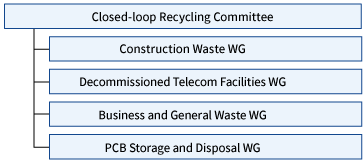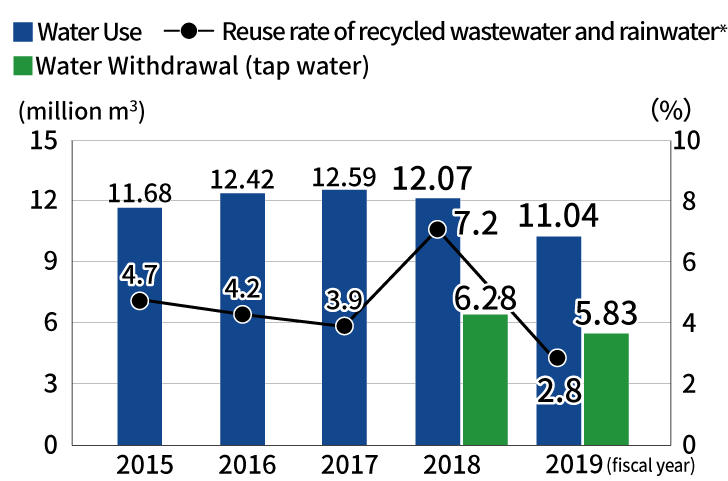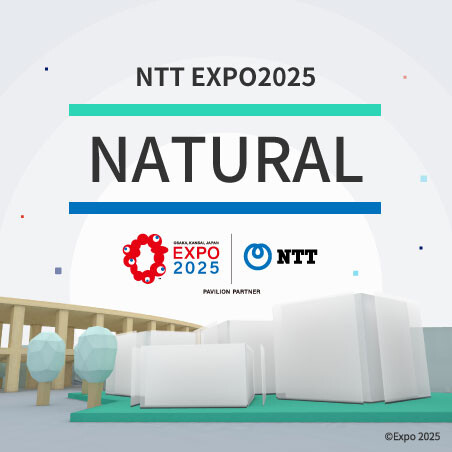Microsoft ends support for Internet Explorer on June 16, 2022.
We recommend using one of the browsers listed below.
- Microsoft Edge(Latest version)
- Mozilla Firefox(Latest version)
- Google Chrome(Latest version)
- Apple Safari(Latest version)
Please contact your browser provider for download and installation instructions.
Implementing Closed Loop Recycling
Implementing Closed Loop Recycling
Although our one-way society of mass production, mass consumption and mass disposal has brought affluence and convenience to our lives, it has brought about various problems such as the creation of massive amounts of refuse, illegal dumping and concern about the depletion of natural resources. To resolve these issues we must first review how companies manage their businesses as well as our social and economic systems, and shift to a closed loop society.
In an effort to realize a future with closed loop recycling, the NTT Group promotes the 3Rs (reduce, reuse and recycle), working to reduce the amount of materials consumed by our business activities and reuse or recycle the resources that are consumed.
Organization for Implementation
The NTT Group has established a Closed-loop Recycling Committee, which works under the NTT Group Global Environmental Protection Promotion Committee. The Closed-loop Recycling Committee has the senior manager of NTT West's real estate planning department as its chair and the people responsible for the environment or facilities at eight major Group companies as members. The committee investigates and promotes closed loop recycling-related measures in the NTT Group, promotes measures aimed at achieving our targets for waste disposal, considers targets and measures for resource procurement and retention, and manages the implementation of these measures.
The working groups (WG) under the committee advance activities according to their respective themes. The Construction Waste WG promotes measures and keeps track of results regarding the disposal of industrial waste produced by construction and public works, the Decommissioned Telecom Facilities WG promotes measures and keeps track of results regarding the disposal of industrial waste produced by decommissioned telecom facilities, the Business and General Waste WG promotes measures and keeps track of results regarding the disposal of office and business-related waste, and the PCB Storage and Disposal WG engages in the storage of PCB waste so that it can be disposed of in an appropriate way.
 Organization for Implementation
Organization for Implementation
[Example] 3R of resources
We presents examples of initiatives toward 3R (Reduce, Reuse, Recycle) of resources.
Reuse and Recycling of Telecommunications Equipment
The NTT Group owns various types of telecommunications equipment and related items including telephone poles, switching equipment, communications cables, public telephone booths and public telephones. These are decommissioned and disposed of when they reach the end of their service life or are replaced during system upgrades for new services and so forth.
We promote the reuse, or recycling, of telecommunications equipment within the NTT Group; for example: recycling concrete waste from discarded concrete poles as road building material. Public telephone booths and public telephones are taken to a specialized intermediate treatment plant, where parts of the booths are sorted into aluminum, stainless steel, glass and plastic. Similarly, the baseboards, copper wires and various plastics in the public telephones are meticulously sorted. They are then sent to a recycling plant to become recycled materials such as rare metals, copper and pellets. The recycling rate there is reflected in the precision, as a result of careful hand sorting, at the intermediate treatment plant.
To prevent the inappropriate treatment of the materials, such as illegal dumping, NTT East collaborated with NTT-ME to construct a system that uses GPS and photography to confirm proper disposal from the site of discharge to the disposal plant.
Reduction in Plastics Use and Promotion of Recycling
The NTT Group is seeking to reduce the use of plastics and promoting recycling. For example, plastic parts of telecommunications equipment such as coverings for branch lines and ready access terminal boxes are used in a closed recycling system in which similar types of disposed covers are recycled into plastics to manufacture new products. We are also seeking to abolish the use of plastic packaging materials for devices used at customers' homes when connecting optical lines such as optical network units (ONU) and home gateway (HGW) units.
Recycling Process for Mobile Phones
Containing gold, silver, copper, palladium and other metals, mobile phones could be regarded as a valuable recycling resource in Japan with its paucity of mineral resources. NTT DOCOMO has accordingly collected used mobile phones from customers since 1998 at its approximately 2,300 docomo shops throughout Japan, and through various events. In fiscal 2019, we collected about 3.87 million* mobile phones, bringing our cumulative total to 115.23 million units collected.
In fiscal 2011, the company introduced a new recycling process for pyrolyzing any plastic used in mobile phones to turn it into oil for use as a fuel, after which gold, silver and other metals are recovered from the residues of this process.
Going forward, we will continue to implement recycling initiatives and contribute to realizing a sustainable society.
*The number of units collected for reuse is included in the figure after fiscal 2016.
Water Management
Due to the nature of the NTT Group's business, little water is consumed in our operations. In Japan, one-year domestic and industrial water consumption totaled 25.9 billion m3*, while the NTT Group's water consumption totaled 5.834 million m3, only about 0.03% of the total for all of Japan. Moreover, our water use is spread out across the country and so we believe our water intake does not have any significant impact on water sources.
The NTT Group reduces its consumption of tap water by using recycled wastewater and rainwater.
 Use of Water Resources
Use of Water Resources
*The reuse rate shown up to fiscal 2017 corresponds to the total volume of tap water and sewage, recycled water, and rainwater used, while the reuse rate from fiscal 2018 onward corresponds to the total volume of tap water, recycled water, and rainwater.
Research centers where we use chemical substances in our research activities implement individual measures against leakages of chemical substances into wastewater. For example, at the Atsugi R&D Center, which carries out research on the physical properties of materials, we have installed equipment to treat chemical-infused waste liquid discharged by the laboratories. Furthermore, we regularly monitor the quality of this wastewater to confirm that it is within legal regulation values. The NTT Group has not been involved in any significant spills.
*From the Ministry of Land, Infrastructure, Transport and Tourism website: Actual water use in fiscal 2015 (water intake basis) was approximately 79.9 billion m3 per year (domestic and commercial use of water: approximately 14.8 billion m3; water for industrial use: approximately 11.1 billion m3; water for agricultural use: approximately 54.0 billion m3).
Paper Management and Recycling
Paper consumption of the NTT Group in fiscal 2019 was 32 thousand tons. As for telephone directories, which account for more than 70% of our paper consumption, we established a closed loop recycling system in 1999 to collect old directories and recycle them to produce new ones. We undertake numerical management for our use of virgin pulp.
Also, we are working to reduce paper consumption of society through the use of ICT, which includes measures such as our Web billing service*.
*A service enabling customers to check their charges and usage at any time online.
Environmental protection activities











